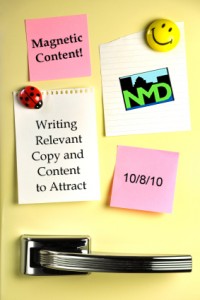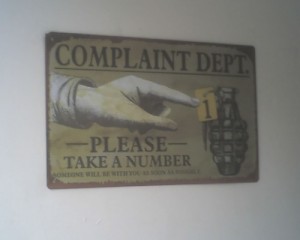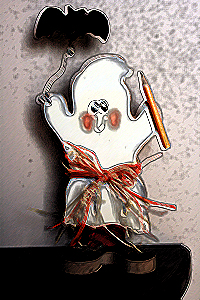Blog
Style Guide Primer
In the post on consistent branding, I suggested creating a style guide. This is a simple process which will save you plenty of time later. To create a print and online style guide, just gather the following items in a paper file folder and in a dedicated computer file folder:
- List of signature fonts
- Standard colors formulas (PMS, CMYK and online color recipes)
- Tagline(s)
- Past promotional ads and tear sheets
Computer Folder:
- Logo(s) in color and in black and white
- Zipped files of signature fonts
- Company biography text (two versions: one longer and one short)
- Key product descriptions and photos
- Headshots of top management (.jpgs)
- List of researched keywords
- Prepared reusable ad copy (elevator speech, mission statement, standard press release, sales sheets, flyers, etc.)
- Contact information and log-in information for all online networks (Facebook, Twitter, industry specific forums, etc.)
Magnetic Content Panel 10/8/10
 I am honored to be part of the New Media Dayton’s October panel called Magnetic Content: Create, plan & position RELEVANT content that will captivate your audience!
I am honored to be part of the New Media Dayton’s October panel called Magnetic Content: Create, plan & position RELEVANT content that will captivate your audience!
1. Gerard McLean — Human Editor in Residence at DogWalkBlog.com
2. Bill Pote — Founder and publisher of DaytonMostMetro.com, an online magazine that features things to see, do and get involved with in the Dayton Region.
3. Shana Douglas — By day: Marketing Director for Sunbelt of Miami Valley with 13 + years of solid B2B marketing experience. By night: Social Diva.
4. Nicole Amsler — Of Keylocke Services, a professional writing, editing and small business marketing firm.
Rock-star Panel Moderator: Carla Weis-Hale
Register for the event here or visit http://NewMediaDayton.com.
Ghostwriting: Outline
This is the second in a series of posts about ghostwriting. Keylocke Services offers ghostwriting services for both fiction and non-fiction books.
The Road Map to Success
A detailed outline is crucial to your ghostwriting project. This is the skeleton of the project as well as the complete road map towards what you want to convey.
The outline occasionally will have its own fee, independent of the book writing. In fact, after this first step, you might feel confident to proceed on your own–perhaps with a bit of editing at the end of the project.
The outline carries the bulk of the responsibility for your book’s direction. The completed outline will guide the research and first draft writing. For example, the ghostwriter will be working on chapters 3 and 4, while the client is reviewing chapters 1 and 2. Typically there are milestone payments as well as milestone due dates.
Keep in mind, changes to the outline, once agreed upon, might also incur addition charges.
When speaking with potential ghostwriters, do ask about having your outline priced separately. Depending how detailed the outline is, you might feel the courage to take the next steps by yourself. But even if you want to outsource the whole project, you want a detailed, expansive outline so you and your ghostwriter are on the same page–and the same map.
If you would like to discuss your ghostwriting project, please email or call me.
Ghostwriting: Investigating
 This is the first in a series of posts about ghostwriting. Keylocke Services offers ghostwriting services for both fiction and non-fiction books.
This is the first in a series of posts about ghostwriting. Keylocke Services offers ghostwriting services for both fiction and non-fiction books.
Getting to Know Each Other
The first step towards launching a ghostwriting project is an investigative phone call. This will help establish the 1.) goal of your writing project, and 2.) the method which your book will be written.
It is also an excellent way to determine how experienced your potential ghostwriter is–as well as giving you a chance to get to know each other.
A non-disclosure agreement is traditionally signed early in the project so there is no fear of ideas being stolen or used with consent. The first questions will likely be discussed with any ghostwriter you are considering.
The initial investigation questions could include:
- Is your book fiction or non-fiction?
- Who is the audience?
- What problem or issue are you addressing?
- How will the book be printed? Distributed?
- Are their extras to the book such as illustrations, diagrams, etc.?
- What research will need to be done before writing? Interviews?
- Is there an outline available? Will one need to be written?
- What is the timeline of the book’s delivery?
- How will revisions be processed? How many revisions are allowed?
- Are their other factors outside the ghostwriter and the client? (ie. corporate compliance, additional editors, family, friends, etc.)
- How can the agreement being dissolved by either party?
- What are the payment terms?
Once many of these questions have been answered, a formal contract is written up and agreed upon. A partial payment is almost always due upfront and a rigorous time schedule is agreed upon. It is important for both parties—client and author—to adhere to these pre-determined timelines.
If you are interested in discussing your ghostwriting project, please email or call me. We can discuss your details and I can provide a no-obligation quote.
Thank You for Complaining
 I am not a complainer by nature. Sure, I will send back a cold entree but I will do it nicely. If I am particularly upset, I will send a strongly worded letter (after all I’m a writer.) But in general, I don’t complain.
I am not a complainer by nature. Sure, I will send back a cold entree but I will do it nicely. If I am particularly upset, I will send a strongly worded letter (after all I’m a writer.) But in general, I don’t complain.
This week, however, I had three complaints to make–with three decidedly different outcomes.
1. I hired a business to fix my paver patio. Instead, they did over $2,000 worth of damage to my whole patio and then refused to answer their phone or messages.
I filed a complaint with the Better Business Bureau and I am hoping for an acceptable resolution. If it is not resolved, you can be sure I will be sharing their name and their shoddy business practices with everyone I know.
2. I had an issue go from bad to worse (which I am not at liberty to share–but trust me, it’s not a pleasant story.) When I called to make a complaint, it was not to ask for anything in return. I just wanted to save other people from the trouble and I felt the business should know so they could fix it in the future.
The first person I spoke with was helpful and apologetic. But he felt the person in charge needed to know the details. When that person called me, she was combative and accusing. Essentially, they wanted me to waste my time and resources to “prove” my complaint.
3. Third time must be the charm. I had a computer issue which required me to use the customer service feature at Carbonite, my online backup system. I have only been using Carbonite for a few months and I needed their assistance quickly and at an odd hour. The problem was solved but it inadvertently removed the program from my computer.
When I was sent a customer service survey, I mentioned how happy I was with my customer service person (Josh) but that I hadn’t been able to reload Carbonite onto my main computer. They had already sent me an automated response, telling me how to reinstall the system so the problem was already fixed.
So I was puzzled when I got another email from Carbonite. But this is what it said:
“We noted in your survey response that you indicated that you were pleased with Carbonite. We are glad to hear of your satisfaction and appreciate your business. We look forward to serving you in the future.
Further, as a token of our appreciation for your having completed our survey and for your business we are adding an additional month to your subscription.”
I didn’t even complain–I actually complimented Carbonite and they still sent me a bonus gift!
This is how customer service should be handled in a world where complaints can be magnified by a massive Twitter feed or viral outreach.
How do YOU handle complaints?
Expert Upon Arrival
I have an article in this month’s WedLock magazine on time management tips for social media. I am often asked to speak on the subject as well. One introduction suggested I was a“social media time management specialist” to which I promptly snorted the water I was sipping up my nose!
There are no experts or gurus in social media concerning time management (or social media, for that matter.) We are ALL learning as we go. It would be like claiming to be the nation’s utmost tour guide for the North America continent upon disembarking the Mayflower. We all just got here and we are all learning as we go.
That being said, I am happy to share the few time saving tips I have discovered with you. Social media has a bad reputation of being a time suck and rightly so. A few time management tips can help whack away some of the brush as we travel further inland.
- Gather ideas for blog posts, Tweets or Facebook updates continuously. This can be on index cards you carry in your wallet or purse, on an open document on your computer or even in the notes section on your phone.
- Blog in batches. Write a month’s worth of blog posts—or at least start a month’s worth of blog posts—in WordPress and then save as drafts.
- Use tools such as Ping.fm, Hootsuite, or SocialOomph to manage more than one platform at a time or to schedule posts and updates.
- If you do not already, start using a RSS feedreader (such as Google Reader) to cut your reading time down. I also schedule a quarterly RSS purge, dropping the blogs that are no longer useful to me.
What tips have you found? How do you tame the social media monster?
Monitoring the Buzz
Are your ears burning? It is always good to know when someone is talking about you, especially if it is favorably. But it is also good to know when your name is mentioned in any light.
The first step towards monitoring your name, business name and even industry, is signing up for Google Alerts. This simple, free application alerts you by email every time your name is mentioned online. I counsel clients to sign up for several keywords:
1. Your name in quotations, such as “Nicole Amsler”
2. Your company name in quotations, ie. “Keylocke Services” or “Keylocke Marketing.”
3. Specific industry terms in quotes, such as “small business marketing consulting” or “copywriter Dayton.” You will want to make sure the keywords aren’t too broad, like “music.” They should also have 2-3 words at minimum.
Once you set up a few Google Alerts, you can begin modifying them as needed. Tweak your keywords until you have exactly the terms you want to follow. You will always want to follow your name and business name. Following competitor names, local events and industry trends can be more transient. Canceling Google Alerts is as easy as starting them.
Assignment: If you haven’t already, start a Google Alert on your name and business name. If you already have Alerts set up, add a few more industry specific alert terms.
The One Thing You Need
Just one? When you start researching how to start a business or even what business to start, the laundry list of everything you need seems to be a mile long.
Are you selling a product? Well then, you need a brochure, maybe a catalog, a price sheet, packaging, shipping boxes, a return policy and a maybe an online store.
Selling a service like life coaching or pet sitting? You’ll need business cards, an hourly fee, networking connections, maybe a website or a magnetic sticker for your car.
And don’t even consider starting a web based company without all the accoutrements. There is a website, of course, plus a blog, electronic signature, maybe a Flash intro and all the online gadgets like a Skype phone line, Aweber list manager and a Paypal account.
The list is so overwhelming you might decide starting your own business isn’t worth the hassle.
But in truth, you don’t need all of those things to get started. To be a success in business you only require one thing.
Just ONE Thing
The only thing you need to succeed is often overlooked. But without it every business is guaranteed to fail.
The big, earth shattering secret? The only thing you need to succeed in business is…customers.
Seems rather simplistic, doesn’t it? Of course, you need customers! But keeping your end goal in mind, how have you set up your business to make sure you get and keep customers?
Many new businesses are created because it sounded like a good idea. Other companies have been created because it is a product or service YOU enjoy, it fits nicely into your skill sets or because it is one of the things you know how to make or do. But the litmus test for a good business venture is to ask this question:
Are there people who will buy this product or service?
If so, where are they and how to do you find them?
Everything else is just gravy. I have met successful business people who do not have a website…or business plan …or business card …or even a single dollar in investment. But they have customers which is the key to their success.
So don’t get bogged down in deciding what the next step you should take in your business. Put off downloading the next gadget. Take a deep breath instead of stressing out over your endless To-Do list.
Instead concentrate on who your customer is. Create a picture of her in your mind. Give her a name. Follow her around in her day to day life. What makes her happy? Where does she shop? What problems can your product or service solve for her?
It’s only after you’ve answered these questions that you can effective marketing to these key customers. All the bells and whistles can be effectively applied. But it all starts with the basic building block of your business—customers.




